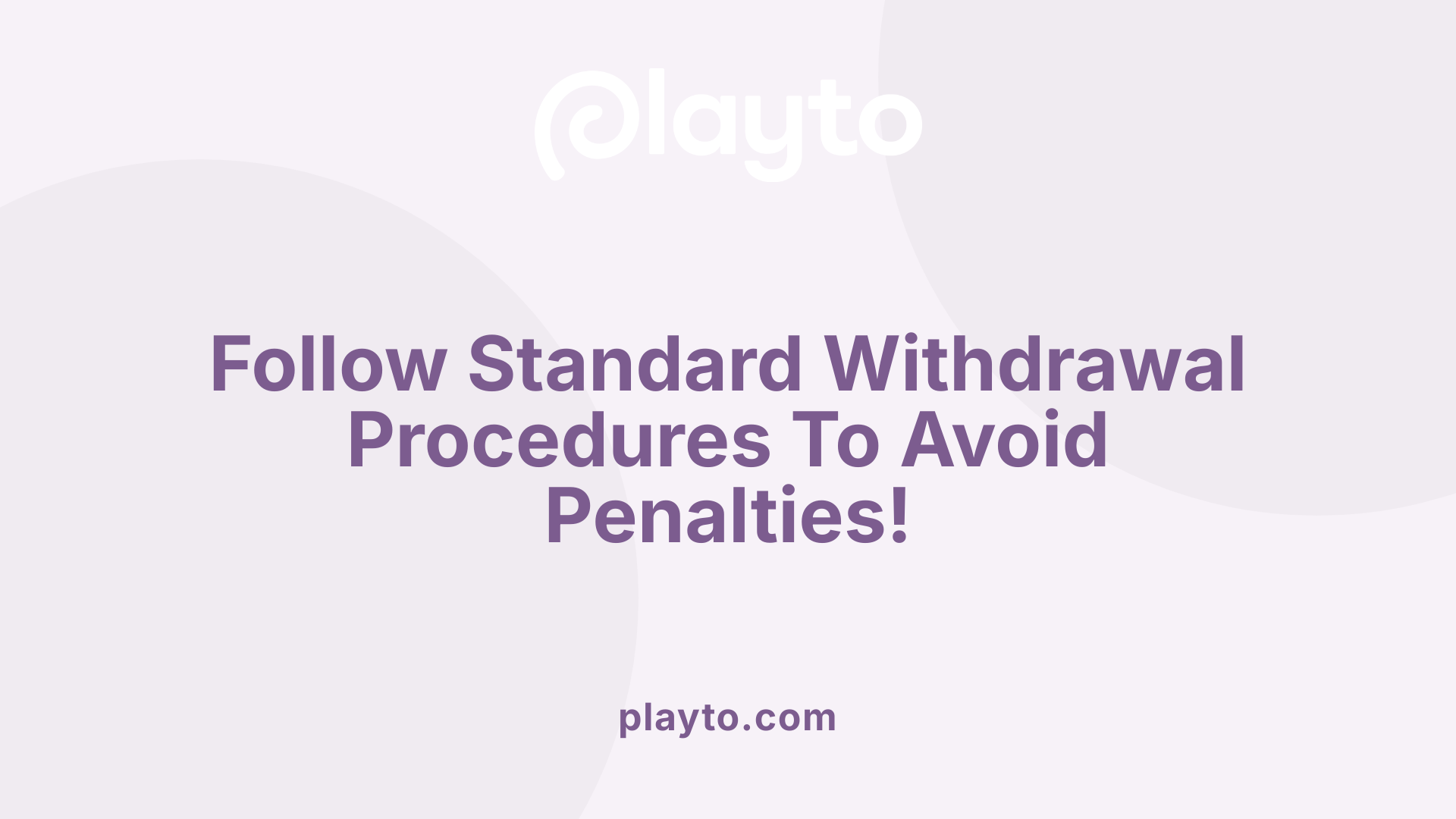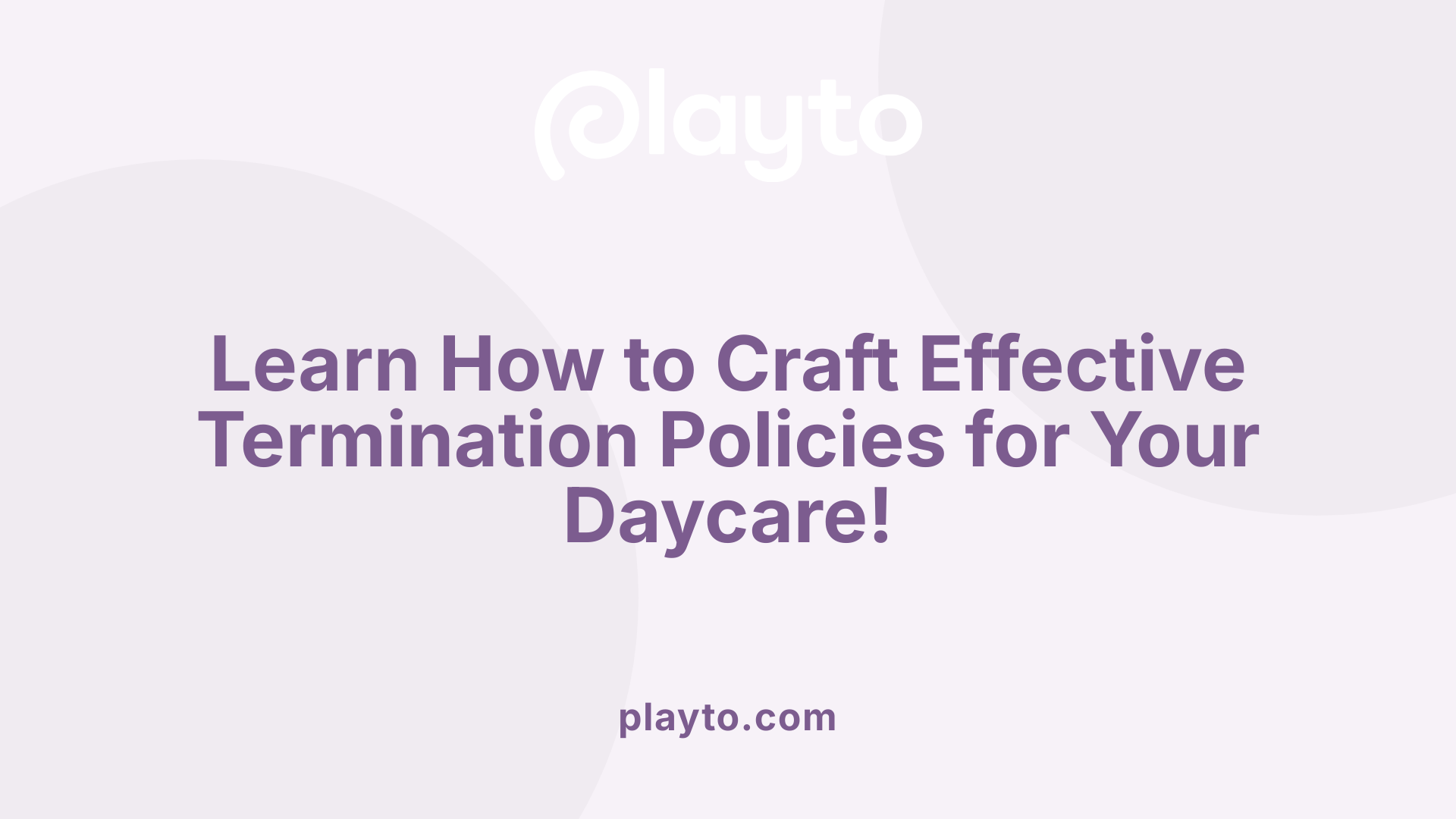Understanding Daycare Withdrawal Policies and Procedures
Withdrawing a child from daycare involves a range of considerations for parents, daycare providers, and children. Understanding the specifics of daycare withdrawal policies is crucial for ensuring a smooth transition. These policies dictate the procedures, legal obligations, and emotional impact involved in terminating daycare services. This article aims to provide comprehensive insights into what parents and providers need to know about daycare withdrawal, including legal responsibilities, effective communication, and emotional support.
Components of an Effective Daycare Withdrawal Letter

What should be included in a daycare withdrawal letter?
A daycare withdrawal letter acts as a formal notification for discontinuing childcare services. Here are the essential elements to include:
- Statement of Intent: Clearly state your intent to withdraw your child from the daycare.
- Child’s Information: Include your child’s full name and any relevant identification or enrollment numbers.
- Last Day of Attendance: Specify the final date your child will attend the daycare.
Expressing gratitude
While the main focus of the letter is to communicate withdrawal, it’s also a good practice to express your appreciation. Acknowledge the care and support the daycare has provided to your child. Mention any positive experiences or specific instances where the staff made a difference in your child’s life. This helps maintain a good relationship and leaves the door open for future interactions.
Adhering to legal requirements
Before sending your withdrawal letter, ensure that it meets any legal regulations or specific policies outlined by the daycare. Many centers require two weeks’ notice to process the withdrawal without penalty. Be mindful of your state’s regulations regarding notices and potential fees. In your letter, it may be useful to include a request for information regarding any remaining formalities or documentation needed for the withdrawal process.
Summary: Key Elements of a Withdrawal Letter
| Component | Description |
|---|---|
| Statement of Intent | Clear notice to discontinue care |
| Child's Information | Full name and any identification numbers |
| Last Day of Attendance | Specify the final attendance date |
| Gratitude | Acknowledge positive experiences |
| Legal Compliance | Follow specified notice periods and document requirements |
| Additional Requests | Ask about further steps in the withdrawal process |
Being thorough in your withdrawal letter not only fulfills contractual obligations but also fosters goodwill as you transition away from a daycare service.
Standard Procedures for Withdrawing a Child from Daycare

What are the standard procedures for withdrawing a child from daycare?
Withdrawing a child from daycare involves several important steps that parents should follow to ensure a smooth transition. First and foremost, a written notice is essential. This notice typically needs to state the reason for withdrawal and the child’s last day of attendance.
Notice periods and contractual obligations
Most daycare centers require a notice period of two weeks, as stipulated in the contract. Here’s a quick breakdown of notice requirements:
| Daycare Center | Notice Required | Final Payments |
|---|---|---|
| Little Giggles Daycare | Two weeks written notice | Fees up to last day |
| Kids' Kingdom Preschool | Two to four weeks | Fees depend on contract |
| General Daycare Policy | Varies; typically two weeks | May include penalties |
This notice ensures that both the parents and the daycare have time to prepare for the change. Failure to provide the appropriate notice could lead to penalties, such as forfeiture of advance payments.
Managing financial considerations
Additionally, it's crucial to discuss any financial obligations before the final departure. Parents should be aware that fees will be charged up to the end of the notice period, even if their child does not attend daycare during that time. For parents benefitting from Child Care Subsidy (CCS), it’s important to note that payments won’t be honored if the child does not attend during the withdrawal notice period.
Being clear about procedures and obligations can help mitigate misunderstandings and create a more positive experience for both parties involved.
Legal Responsibilities During Daycare Withdrawal

What are the legal obligations when withdrawing a child from daycare?
Withdrawing a child from daycare involves several important legal obligations that parents must follow to ensure a smooth process. Most daycare contracts stipulate that parents must give a two-week notice before termination. This policy is designed to allow the daycare time to prepare for the child's departure and to possibly fill the vacancy.
Parents must also be aware of any potential termination fees or financial responsibilities that may arise. For instance, full payment is often required through the end of the notice period, even if the child does not attend during those final weeks. This ensures that the daycare can manage its finances effectively despite the withdrawal.
It is advisable for parents to communicate their withdrawal directly and respectfully with the daycare's administration. A well-crafted termination letter, clearly stating the reason for withdrawal, not only provides clarity but also can help daycare providers improve their services in the future.
Finally, maintaining proper documentation is crucial. Both parents and daycare staff should keep comprehensive records of all communications related to the withdrawal. This helps avoid any misunderstandings and serves to protect both parties legally.
Summary of Important Withdrawal Policies
| Policy Aspect | Required Action | ----------------------------------- | ------------------- | Notice Period | Two weeks written notice required
| Final Payments | Fees due until the notice period ends, regardless of attendance
| Documentation | Keep records of communications regarding withdrawal
| Termination letter | Recommended to clarify reasons for withdrawal
Parents' Rights and Responsibilities in Daycare Withdrawal

What are parents' rights and responsibilities during the daycare withdrawal process?
Parents hold the right to withdraw their child from daycare at any point. However, this decision comes with responsibilities that are often outlined in a daycare contract. It is essential for parents to honor the required notice period, typically around two weeks, and ensure all final payments are settled. Communication plays a crucial role in this process; parents should inform the daycare provider to facilitate a smooth transition, minimizing disruption for both the child and the daycare staff.
In joint custody situations, communication becomes even more important. Both parents generally must agree on the withdrawal of the child from daycare. A non-custodial parent cannot make this decision independently unless legally permitted by a court order. This necessitates thorough discussions and, if needed, mediation can serve as a less confrontational method for resolving disagreements about the withdrawal.
Ultimately, it is wise for parents to consult a family law attorney if disputes arise. Legal fees and court costs can escalate, so gaining clarity on custody agreements can prevent unnecessary financial burdens. Mediation and legal guidance can support parents in navigating complex withdrawal situations and promote cooperation between both parties.
Crafting and Enforcing Effective Daycare Termination Policies

How can daycare providers create effective termination policies?
Daycare providers can create effective termination policies by clearly defining conditions for contract termination within their agreements with parents. This includes specifying notice periods and outlining financial obligations in detail. For example, many daycare centers require a two-week notice for withdrawal, ensuring parents understand their responsibility for payments during this time.
Additionally, these termination policies should be documented in the parent handbook. This handbook should comprehensively cover procedures for withdrawal, expected behavior, and consequences of policy violations. A well-structured handbook instills confidence among parents, knowing they have accurate information regarding the daycare's procedures.
Importance of Communication and Training for Staff
Regular training for daycare staff on these policies is vital. Providers should also maintain open communication with parents, addressing any concerns before they escalate into formal termination. This proactive approach can significantly reduce grievances and foster a collaborative environment.
Summary Table of Key Policies
| Policy Aspect | Description | Impact on Parents |
|---|---|---|
| Notice Period | Typically two weeks for withdrawals; ensures parents are aware of fees during notice period. | Helps parents plan financially. |
| Documentation | Written policies included in the parent handbook; enhances transparency. | Ensures clarity and understanding. |
| Training for Staff | Regular updates on policies to staff; aids in consistent enforcement of rules. | Builds trust in caregivers. |
| Communication | Open lines for feedback and concerns; encourages collaboration and conflict resolution. | Prevents misunderstandings. |
By emphasizing these elements, daycare providers can establish robust termination policies that protect their interests while considering the needs of families.
Emotional Considerations for Daycare Withdrawal
What are the emotional considerations for parents and children during the daycare withdrawal process?
The emotional considerations for parents and children during the daycare withdrawal process are significant and multifaceted. Children often experience separation anxiety, which can manifest as excessive crying, clinginess, or even physical symptoms, indicating their emotional distress as they encounter changes.
To support children, parents should help their child understand the transition. This can include establishing a consistent routine and creating a comforting environment to ease anxiety. Open communication about the reasons for the change is essential to mitigate fears and uncertainties.
Parents themselves may navigate feelings of grief or relief regarding the decision to withdraw. They should acknowledge these emotions and discuss them both with their child and caregivers, reinforcing the importance of solid relationships.
By validating each other's feelings through supportive interactions during drop-offs, families can foster resilience and emotional well-being, promoting a smoother transition for everyone involved.
Creating a Comprehensive Daycare Parent Handbook Section on Withdrawal
Inclusion of Withdrawal Policies
A daycare parent handbook should explicitly outline the withdrawal policies to ensure clarity for all families. This includes details on how parents can formally notify the daycare about their decision to withdraw their child. Clear instructions not only foster understanding but also help parents feel more secure in their choices.
Details on Notice Periods and Penalties
It's essential to specify the required notice periods for withdrawals, typically ranging from two to four weeks. For example, parents might need to provide a two-week written notice, detailing their reason for withdrawal and the child’s last day of attendance. Furthermore, potential penalties, such as fees up to the end of the notice period, should be clearly stated to avoid misunderstandings.
Guidance for Smooth Transitions
Providing guidance for smooth transitions can significantly benefit families. This includes advice on how to prepare children for the change and what steps they can take to ensure a positive experience for everyone involved. Offering support during this time can help ease the emotional impact of the withdrawal process.
Conclusion
Understanding and navigating daycare withdrawal policies can ease the transition for parents, children, and providers alike. By adhering to legal and contractual obligations, maintaining open communication, and considering the emotional impacts, families can ensure a respectful and smooth conclusion to daycare services. Providers, on the other hand, can foster a supportive environment through well-drafted termination policies and thorough communication, ensuring mutual respect and satisfaction for both parties. This comprehensive knowledge empowers all involved to manage daycare withdrawal effectively and compassionately.
References
- Daycare Termination Policy: The Complete Guide for Managers
- Termination Policy - Little Giggles Daycare - Google Sites
- Child Dismissal Withdrawal Policy of Kids' Kingdom Learning Center ...
- What To Include in Your Child Care Parent Handbook
- How to End a Childcare Relationship - FamilyEducation
- Daycare Termination Letters for Providers - Templates & How To
- Withdrawal of a Child Policy - SweetProcess
